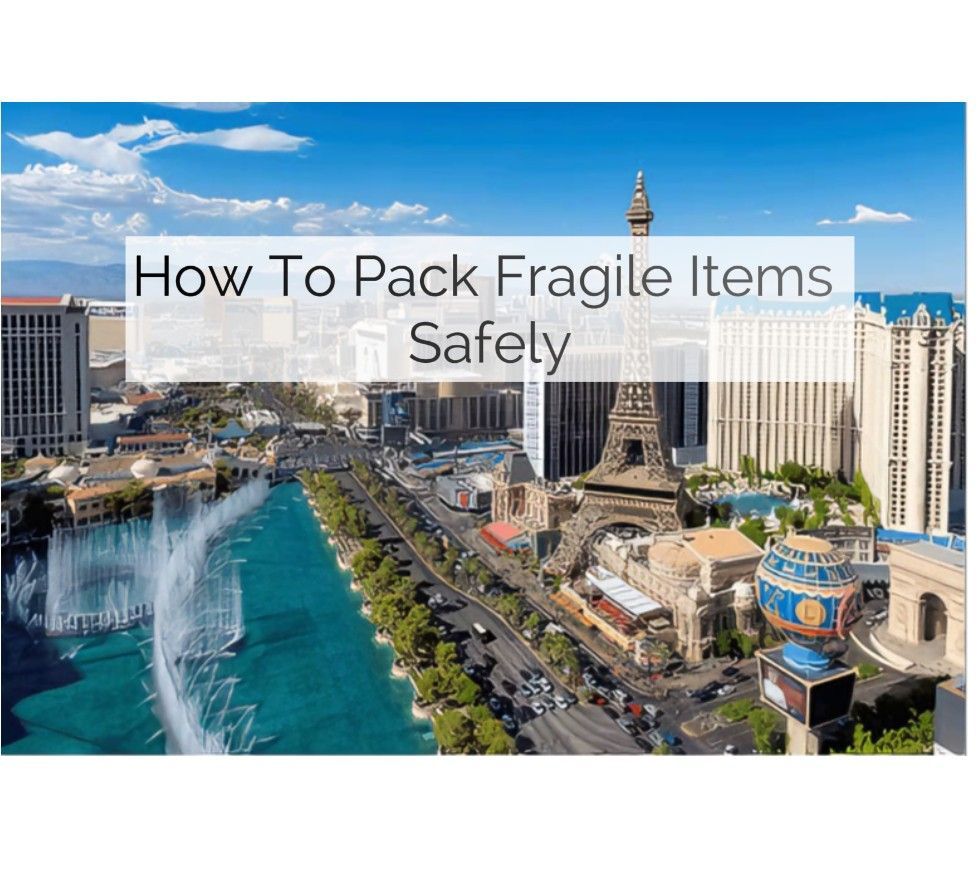How to Pack Fragile Items Safely: Your Ultimate Guide for a Smooth Move

Moving is often cited as one of life's most stressful events, and the thought of packing delicate heirlooms and cherished breakables can add another layer of anxiety. The good news is that with the right approach and proper materials, you can significantly reduce the risk of damage. This guide will walk you through everything you need to know about how to pack fragile items safely, ensuring your precious belongings arrive at your new home intact.
Whether it's a collection of delicate glassware, an antique vase, or sensitive electronics, understanding the best packing techniques is crucial. And remember, for those in the Las Vegas area seeking professional assistance with their delicate items, 87 Movers Las Vegas is always ready to provide expert packing and moving services.
What Essential Supplies Do You Need to Pack Fragile Items Safely?
To pack fragile items safely, you'll need a specific set of high-quality packing materials designed to provide maximum protection. Using the right supplies is the first critical step in preventing damage during transit.
- Strong Moving Boxes: Opt for sturdy, double-walled corrugated boxes, especially for heavier or more delicate items. Look for specialized boxes like dish pack kits (cell kits) that offer built-in dividers.
- Bubble Wrap: Essential for cushioning and shock absorption. Purchase various sizes, from small bubbles for glassware to large bubbles for larger, more robust items.
- Packing Paper/Newsprint: Ideal for wrapping individual items, filling voids, and providing a clean, scratch-free layer of protection. Avoid using newspapers directly on items that could smudge.
- Packing Peanuts: Excellent for filling empty spaces in boxes and cushioning irregular-shaped items.
- Packing Tape: Use strong, wide packing tape (2-3 inches) to seal boxes securely. Invest in a good tape dispenser for efficiency.
- Markers: Clearly label boxes as "FRAGILE" and indicate their contents and the room they belong to.
- Scissors or Box Cutter: For cutting tape and opening packing material.
Furniture Pads/Moving Blankets: Useful for protecting larger fragile items like mirrors or artwork.
How Do You Prepare Fragile Items Before Packing?
Before you begin the actual packing process, proper preparation of your fragile items is key to their safety. This includes cleaning, disassembling, and assessing their unique vulnerabilities. Packing electronics safely asserts its importance, given our reliance on devices for both personal life and work.
- Clean and Dry Items: Ensure all items are clean and completely dry before packing. Moisture can lead to mold, mildew, or damage to certain materials.
- Disassemble Where Possible: For items like lamps or small appliances, remove any detachable parts (shades, bulbs, cords). Wrap these components separately.
- Document Valuables: For highly valuable or sentimental fragile items, consider taking photos or videos before packing. This serves as a record for insurance purposes if anything is damaged.
- Assess Fragility: Take a moment to consider the unique fragility of each item. Some items may require extra layers of protection or specialized packing techniques.
What's the Best Way to Pack Dishes and Glassware?
Packing dishes and glassware requires meticulous attention to detail to prevent chips, cracks, and breaks. This is often one of the most common categories for damage during a move.
For plates, bowls, and platters:
- Wrap Individually: Place a stack of packing paper flat on a surface. Place one plate in the corner of the paper and bring the corner over the plate.
- Roll and Tuck: Continue rolling the plate, tucking in the sides as you go, until the entire plate is covered. Use 2-3 sheets of paper per plate.
- Bundle: For extra protection, create bundles of 3-4 wrapped plates, securing them with tape or more paper.
- Pack Vertically: Place bundled plates vertically in the box, like records. This distributes pressure more evenly and reduces the chance of breakage compared to stacking them flat.
For glasses and stemware:
- Crumple Paper Inside: Crumple a small piece of packing paper and place it inside the glass to provide internal support.
- Wrap Individually: Wrap each glass thoroughly with 2-3 sheets of packing paper, starting from the rim and working down, creating a protective cushion.
- Use Cell Kits: Utilize dish pack boxes with cell dividers. Place wrapped glasses individually into the cells.
- Pad the Bottom: Add a layer of crumpled packing paper or bubble wrap at the bottom of the box for cushioning before placing items.
- Fill Voids: Fill any empty spaces in the box with crumpled paper or packing peanuts to prevent shifting.
How Do You Pack Mirrors, Artwork, and Frames Safely?
Large, flat, and often delicate items like mirrors, artwork, The Art and Antique Moving Services always pay close attention to detail and picture frames require specialized packing techniques to protect their surfaces and structural integrity.
- Cross Tape the Glass: For mirrors and framed art with glass, apply painter's tape in a starburst or "X" pattern across the glass surface. This helps hold the glass together if it shatters, preventing shards.
- Wrap with Packing Paper: Cover the entire item with several layers of packing paper.
- Bubble Wrap Generously: Wrap the item thoroughly with large bubble wrap, securing it with tape. Pay extra attention to corners and edges.
- Cardboard Reinforcement: Cut pieces of cardboard to fit over the corners of frames or mirrors and secure them with tape. For added protection, sandwich the wrapped item between two larger pieces of cardboard cut to size, then tape them together securely.
- Use Mirror Boxes: For larger items, invest in specialized mirror boxes (also called picture boxes). These telescoping boxes can be adjusted to fit various sizes.
- Pack Vertically: Always transport mirrors and artwork vertically on their edges, never flat.
What's the Safest Way to Pack Electronics and Small Appliances?
Electronics and small appliances contain delicate components that need careful handling to avoid damage during a move. Proper packing protects against impact and static electricity.
- Original Packaging is Best: If you still have the original boxes and packing materials for electronics, use them! They are designed to protect the specific item.
- Take Photos of Connections: Before unplugging, take pictures of how cables are connected to your devices.
- Bundle Cords and Accessories: Disconnect all cords, cables, and accessories. Label them or put them in clearly marked Ziploc bags, taping the bag to the corresponding device if possible.
- Wrap Individually: Wrap each electronic item and small appliance (e.g., toaster, coffee maker) in bubble wrap or several layers of packing paper.
- Cushion Thoroughly: Place a layer of crumpled packing paper or bubble wrap at the bottom of a sturdy box. Place the wrapped item in the center.
- Fill Voids: Fill all empty spaces with crumpled paper, packing peanuts, or bubble wrap to prevent shifting.
- Label Clearly: Mark boxes containing electronics as "FRAGILE" and "ELECTRONICS," and indicate "THIS SIDE UP."
How Should You Pack Collectibles and Irregularly Shaped Fragile Items?
Items like figurines, sculptures, and other unique collectibles often have irregular shapes and extreme fragility, requiring custom packing solutions.
- Wrap Protrusions First: For items with delicate protrusions (e.g., arms on a figurine), wrap those parts individually with a small piece of bubble wrap or extra packing paper before wrapping the entire item.
- Layered Wrapping: Wrap the entire item generously with multiple layers of bubble wrap, securing each layer with tape. The goal is to create a soft, protective cocoon.
- "Box within a Box" Method: For extremely valuable or fragile items, consider the "box within a box" method. Place the thoroughly wrapped item in a small, sturdy box. Fill any voids in this inner box with packing peanuts. Then, place this smaller box into a larger moving box, surrounding it with packing peanuts or crumpled paper for an additional layer of shock absorption.
- Custom Foam Inserts: For highly valuable or uniquely shaped items, consider custom-cut foam inserts for maximum protection.
- Label Meticulously: Clearly label these boxes as "EXTREMELY FRAGILE - DO NOT STACK" and detail the contents.
What Are Key Tips for Loading and Transporting Fragile Boxes?
Even perfectly packed fragile items can break if not loaded and transported correctly. Strategic placement in the moving truck is paramount.
- Label Clearly: Every box containing fragile items should be clearly marked with "FRAGILE" on multiple sides and "THIS SIDE UP" arrows.
- Load Last, Unload First: Fragile boxes should typically be loaded onto the moving truck last and unloaded first. This minimizes the time they spend under other boxes.
- Do Not Stack Heavily: Never stack heavy boxes on top of boxes marked "FRAGILE." Ideally, fragile boxes should be on top of sturdy, non-fragile items or in a dedicated section where they won't be crushed.
- Fill All Voids: Within the truck, ensure there are no large empty spaces where boxes can shift during transit. Use moving blankets, pillows, or soft items to fill gaps.
Secure Items: Use tie-downs or straps to secure furniture and other large items, preventing them from shifting and potentially crushing fragile boxes.
Key Takeaways for How to Pack Fragile Items Safely
Successfully packing fragile items for a move boils down to preparation, proper materials, and meticulous execution. Here's a quick recap of the most important points:
- Invest in high-quality packing supplies: sturdy boxes, ample bubble wrap, and packing paper.
- Wrap each fragile item individually and thoroughly, providing internal and external cushioning.
- Use specialized boxes like dish pack kits for glassware and mirror boxes for artwork.
- Pack plates vertically and fill all voids in boxes to prevent shifting.
- Label all fragile boxes clearly on multiple sides.
- Load fragile boxes last and unload them first, ensuring they are not crushed by heavier items.
Packing fragile items safely might seem daunting, but by following these detailed steps and investing in the right materials, you can significantly reduce the risk of damage during your move. Remember, patience and careful execution are your best allies when dealing with delicate possessions. For those in the Las Vegas area who prefer to leave the intricate task of packing fragile items to the experts, 87 Movers, your movers in Las Vegas offers reliable and efficient packing services, ensuring your valuable and cherished items arrive at your new destination securely and intact. A little extra effort now can save you a lot of heartache later, making your moving experience as smooth and stress-free as possible.


